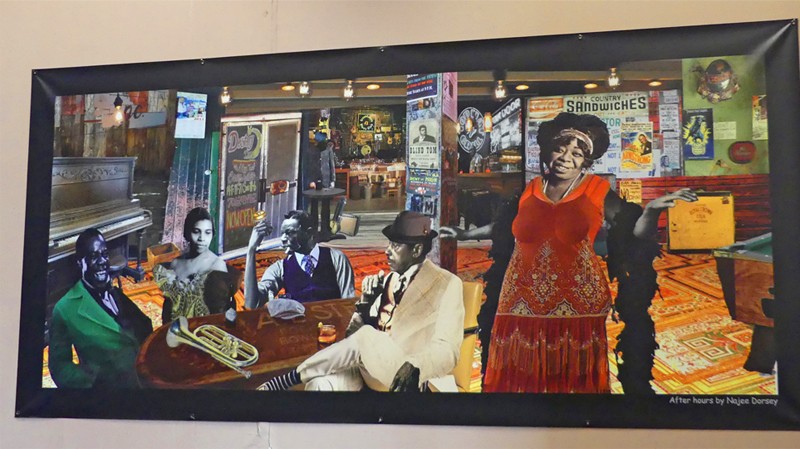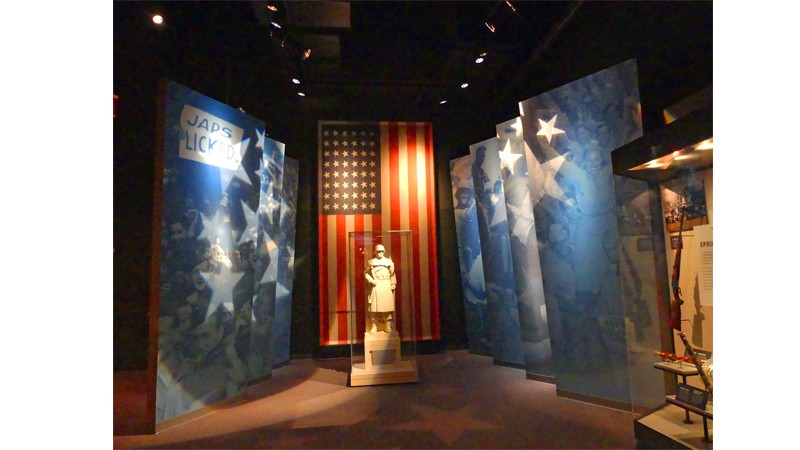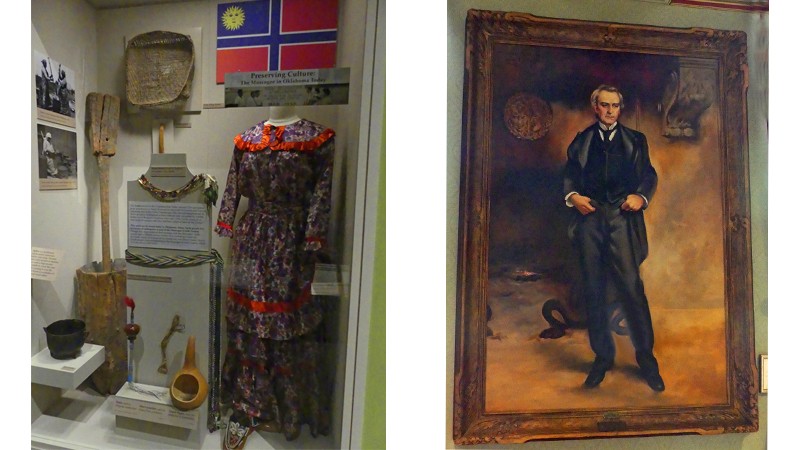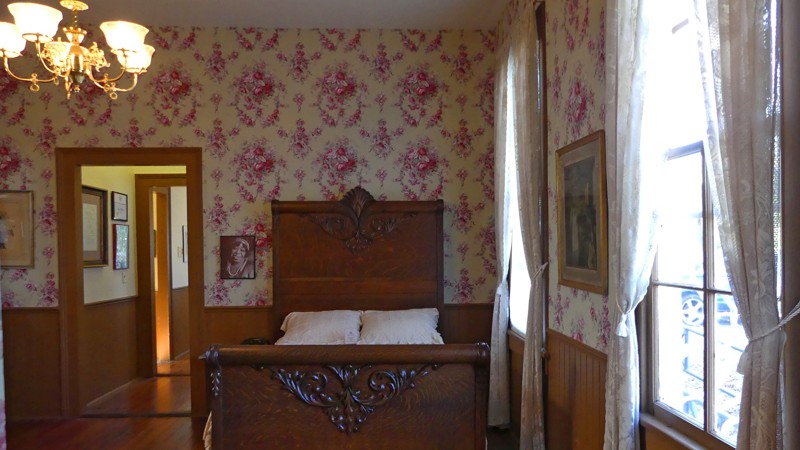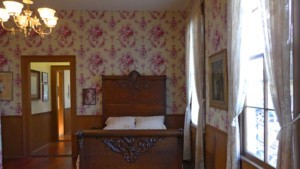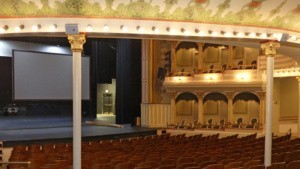COLUMBUS, GEORGIA: Where History Is So Close You Can Touch it
By Kathleen Walls
Step back in time to 1828 to the brand new city of Columbus, Georgia. High on a bluff overlooking the Chattahoochee River, the location is perfect for the new industrial city. Earlier the river had nourished the pastoral Creek Indians.
Columbus Museum is a natural starting place for any Columbus visitor.
It’s a combination of art and history. The art is colorful and ranges from Chihuly to exquisite furniture. The history goes back to prehistoric times with a large display of arrowheads and spear points, a huge mastodon tusk, and pottery ranging back to the Woodland and Mississippian periods.
More modern day history relives the American struggle to move westward. There are well–thought-out displays of different periods up to the more modern times like the 1996 Olympics. The museum is not just for adults. There are classes to give kids an appreciation of history.
Civil War Naval Museum is a one-of-a-kind treasure tracing the Civil War on all the waters.
Driving up you spot the USS Water Witch, a replica Union side-wheel Steamship. Inside there are more historical treasures. One-of-a-kind relics like the recovered Ironclad CSS Jackson. The Jackson was built in Columbus Shipyard than burned and sunk in the Chattahoochee River in 1865 before ever seeing service. Almost a century later the hull was raised and a “ghost frame” fitted to show the original dimensions.
Another ship displayed is the CSS Chattahoochee, scuttled by the Confederates to prevent its falling into Union hands. Due to being submerged, she is the only twin-screw steam-powered Confederate gunboat existing today.
Our docent, Brandon Gilland, began with a demonstration of life of a Civil War sailor. There’s a touch of other Civil War events with a temporary exhibit “Victory From Within:
The American Prisoner of War Experience” from Andersonville National Historic Site showing life in a Confederate prison.
Columbus’s well-to-do citizens demanded entertainment. Thus in 1871 the Springer Opera House was built.
It was recognized as the finest theatre between New York and New Orleans. Performers like Edwin Booth, brother of the man who shot President Lincoln, portrayed Hamlet to a packed house in 1876. Other famous actors who trod the boards there including Ethel Barrymore, Buffalo Bill, Lilly Langtry, and Will Rodgers performed there as well as personalities like Theodore Roosevelt, Truman Capote and Hal Holbrook, who recently performed there.
Our guide, Aileen Fowles, led us through the gallery of portraits of former performers. She told us something of the Springer‘s ghost legends. Edwin Booth’s ghost is reputedly there along with many other spirits. One of the most noted occurrences concerns costume staff. The story is that if a staffer needs a certain costume all she has to do is say it and leave for a few minutes. When she returns the costume is laid out in easy sight.
Because of Jim Crow Laws, African Americans were only allowed in the upper balcony of the Springer but in 1925, African Americans got their own Liberty Theater.
It was the local hotspot for black entertainers, showing live performances, silent movies and then talkies. The theater closed in the ‘70s due to desegregation. Today, it’s restored and open for events and tours. They offer about four live performances annually. When you enter the lobby, you are greeted by the painting Liberty Legends by Najee Dorsey depicting Louis Armstrong, Marian Anderson, Nat King Cole, Cab Calloway, and Ma Rainey, all of whom appeared at the Liberty. Liberty Theater is on the National Register of Historic Places.
Ma Rainey’s Home is another historical hotspot. Ma Rainey was born Gertrude Pridgett in Columbus in 1886. She was known as “Mother of the Blues” and released over 100 records with Paramount. The home is a modest two-story place in what the traditionally “Black” section. It’s a good marriage between Ma Rainey the person and her musical image with many of her original records and posters from her career. Ma’s piano, once painted bright green, now restored, stands in her hall. Deb Wise, our guide, told us about the history of one of my favorite personal items, Ma’s bedroom set, “her relative sold it to a local antique shop for $200 and we had to pay $15k when the city restored the house.”
National Infantry Museum was voted #1 Best Free Museum by USA Today.
It’s adjacent to Fort Benning where U.S. Army Infantry train. Our guide, Jim Talley, explained the museum’s mission statement, “To honor those who have gone to defend our country.” It honors all military but focuses on infantry as the front line of defense.
After passing the circular entrance representing the traditional infantry drum, you walk “The Last 100 Yards” into eight scenes recreated from American wars beginning with the “Capture of Redoubt #10 at Yorktown” in the American Revolution.
The display proceeds through Civil War, WWI, WWII, Korean War, Vietnam War, onto the ongoing desert warfare. Each of the soldiers were cast from present day combat soldiers. Looking closely at the displays you can see muscle, veins, and details that make them so realistic.
You could spend days in this museum reading the information and studying exhibits that retell the story so graphically. Besides the main gallery, each war has its own gallery. When you reach the back window and look out, you see the final pieces of history. There is a small WWII village adjourning the parade grounds comprised of buildings constructed to house and maintain the soldier’s needs. It was originally planned to be torn down after the war but locals prevailed and preserved this precious piece of history.
The graduating classes stand on the green adjourning this village and family and well-wishers sit in bleachers for the ceremony. The grounds where these soldiers parade has been enriched by buckets of soil brought from each battlefields where American Infantrymen fought and died. On this field, you literally stand on history.
Columbus’s motto, “From past to future in a few city blocks.” See www.VisitColumbusGA.com
Kathleen Walls is publisher/writer for American Roads and Global Highways (www.AmericanRoads.net). A member of the International Food Wine & Travel Writers Association (www.IFWTWA.org), her articles and photographs have appeared in numerous magazines and online publications. Her in-print travel books to date are: ‘Georgia’s Ghostly Getaways’, ‘Finding Florida’s Phantoms’, ‘Hosts With Ghosts’ and ‘Wild About Florida: South Florida’, ‘Wild About Florida: North Florida’, and ‘Wild About Florida: Central Florida’. She has several travel guides online as well. Her fiction, which often leans heavily on her travels, includes ‘Last Step’, which was made into a feature movie of the same name by Forbes Productions, ‘Kudzu’, ‘Under A Bloody Flag’ and ‘Under A Black Flag’.




